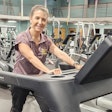Adding a balance center to your facility can help address an important need in the older adult community.
Do you have a Pilates, yoga, group cycling or personal training studio or area in your fitness center? If so, odds are that you offer these programs due to either a growing demand, or a vision that these programs could offer you new ways to meet your clients' needs. So what is the next opportunity? For the first time in history, there are now more people in the U.S. older than 45 than younger. Because of this, many new opportunities are available for fitness and healthcare. One such opportunity is a "balance center."
What is a balance center, and why should your fitness center offer one? Let's take a closer look at this opportunity.
Why a balance studio, clinic or center?
Creating a balance center offers you the ability to address the changing demographics in the U.S. Statistics about this market include the following:- Few older people are screened by their physicians for balance issues until they fall.
- One out of every three people older than 65 will fall this year.
- 50 percent of people older than 65 who have fallen will fall again in the next 12 months.
- Strength and balance training programs could reduce the number of falls by up to 40 percent.
- Once an individual has fallen, the fear associated with falling again can lead to social isolation, depression and a downward spiral in health.
- The emotional and financial effects on families and caregivers due to falls can be immense.
The program
Imagine this: Upon entering your fitness center, members walk over to what was once a poorly used room or space. This area was transformed into your new Balance Center. The waiting area for balance and fall risk-assessments is full, as one client after another goes through your new assessment program. Upon completion of these assessments, an appointment is scheduled, and a copy of the report is emailed or faxed to three people: your client's doctor, your balance training specialist and your billing department. Your balance specialist then calls to discuss a course of action with the client's doctor. First, they establish if any health issues exist that would preclude your client from moving forward. Next, they find out if there are any drug interactions that may cause balance issues, especially considering the fact that 75 percent of people 65-plus take at least one prescription medication, and the average number of medications taken by people over 65 ranges from two to four.Once a program is created, your well-educated balance specialist will schedule the client's first session. You can find these specialized trainers at California State Fullerton's Center for Successful Aging, or other college or university. The programming area would have everything from basic wobble boards and strength equipment to a cobblestone path, or more sophisticated computerized strength and balance tools. No matter what the tools are, the client's progress is monitored.
After the training session, your clients may wish to read one of your many publications or handouts on balance, strength training or other topics. They may also register for your weekly educational seminar. This week's session is called "Hazards in the Home." The session looks at fall hazards, such as poor lightening and loose carpeting. The key is to educate without being preachy or condescending - everyone already knows that falls are dangerous.
This is only the start. Now it's your turn. Sit back and dream about how you could turn the concept of a balance center into a profit center.




































